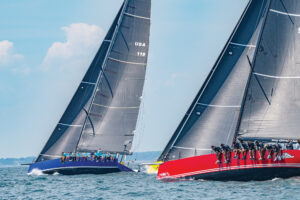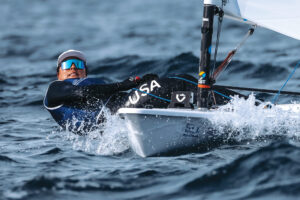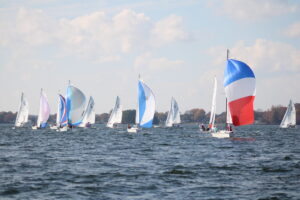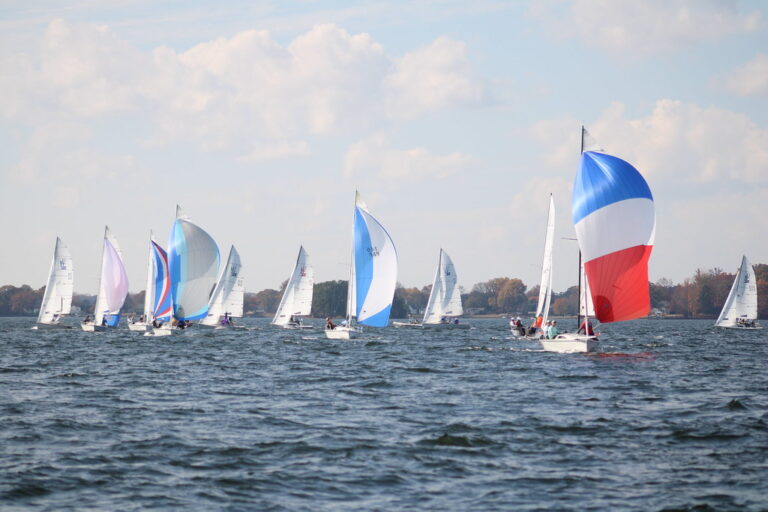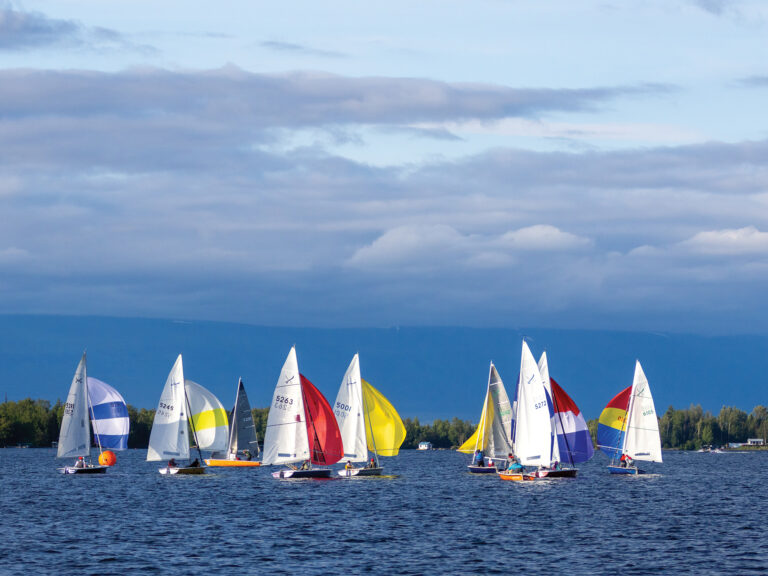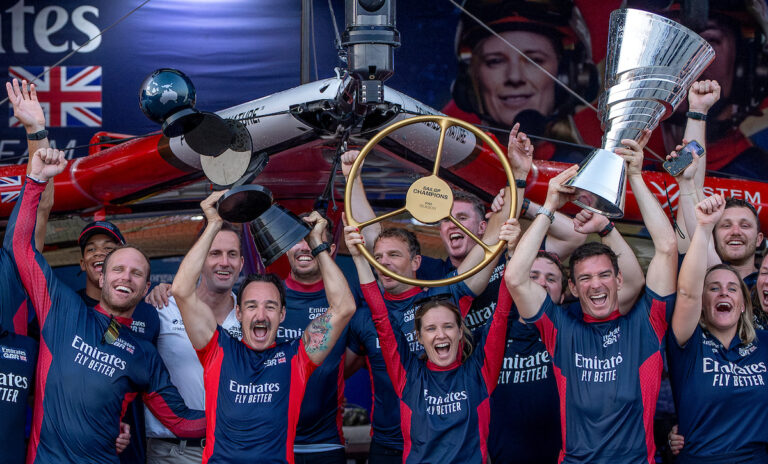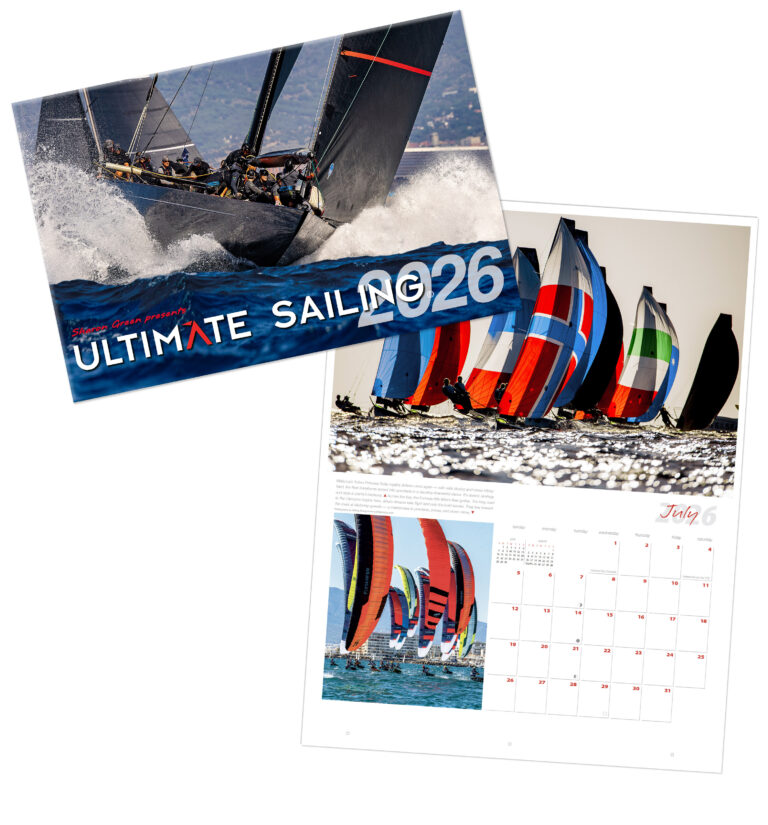The America’s Cup rumor mill is back in full swing. The latest story making the rounds has the event being staged in Italy in 2013 using 60 wing-masted multihulls. Adding fuel to this rumor is the appearance of BMW Oracle’s Glenn Ashby and James Spithill at this week’s International C-Class Catamaran Championship, lovingly referred to as the “Little Americas Cup”. The duo is sailing the yacht Alpha against five other international teams in the weeklong event, taking place off Newport, R.I. (Ed. Ashby and Spithill won the first race, and sit in first place after Day 1. Find the latest in SW’s Finish Line forum.)
Since wings are all the rage now, and notables such as Juan Kouyoumdjian, Tom Schnackenberg, Kevin Shoebridge, and Dirk DeRidder are in Newport to study the wings, let’s explore how a wing rig works on a sailboat.
The C-class rule is quite simple. Build a symmetrical catamaran 25 feet long, 14 feet wide, and with a sail area of 300 square feet or less, and you’re in. The devil, of course, is in the details. Modern C-class boats are at the cutting edge of design and technology, and the wings are works of art. It’s no wonder why BMW Oracle secured the services of Fred Eaton and Magnus Clarke, the current Little America’s Cup holders, when they decided to pursue a wing sail for the 33rd America’s Cup. The wing, in fact, has been critical to the success of the C class for many years, since a wing can produce nearly twice the driving force of a soft sail of a given area.
Typical C-class wings consist of three elements: a twistable leading edge section that doubles as the main load carrying member (Element 1), an interim flap that can deflect to a small angle (Element 2), and a large, slotted, trailing-edge flap that can deflect up to 45 degrees (Element 3). (Due to time constraints and build simplicity, BMW Oracle’s wing only consisted of two elements, the leading edge and large, trailing-edge flap.) The wings are built of a series of carbon frames and then covered with heat-shrink plastic—much the same way as a model-airplane wing is built.

Detailed view of Alpha’s wing. Element 1 is furthest to the left, followed by the smaller Element 2, and trailing edge Element 3.
Controlling the wing is a matter of adjusting the twist and camber. With a conventional soft sail, twist occurs naturally in the sail and can be controlled with vang and mainsheet. On a wing sail, twist has to be physically manipulated into the wing. Steve Clark, designer of Cogito, Aethon, and Patient Lady VI, explains. “The main structural element of the wing is a round mast,” he says. “This is inside Element 1 of the wing forward of the quarter chord. The wing surface is attached to this spar above the hounds such that the spar rotates with the wing surface. Below the hounds, the wing is located on the spar with saddles, but is free to rotate relative to the spar.”
At the bottom of the wing, there’s a large, boom-like structure (called the Boom Box), which is the foundation of the wing-control system,” continues Clark. “This is attached to the wing surface but can rotate about the spar. At this height, the spar has a rotation tiller, similar in all respects to what you see on any beach cat. If the tiller is centered on the boom box, the wing above the hounds lines up with the boom box, and there is no twist. If the tiller is eased, the wing above the hounds will be eased by the same amount, thus twisting Element 1 below the hounds. As the flap angle is controlled by a system that has all of its foundations on the wing, flap angle is unchanged by twist. So all the twist happens in the bottom 25 feet or so of the wing, which is where the greatest speed differences in boundary layer occur. That is at least how all of the Cogito wings operate, and 5 of the 7 [Ed. As it happens, 6] wings at Newport will work this way. Patient Lady VI‘s wing was built before we thought of this and only has the ability to wash out flap angle.”

_Wing control system on _Alpha.
Magnus Clarke, crew on_ Canaan_, further discusses the control system. “The aft flap twist control is a relative system,” he says. “Essentially, the delta translates the camber angle at the boom box to the camber angle at the hounds. If you ease the system, it’s the base camber angle, minus whatever you ease into it. So 20 degrees minus 10 equals 10 degrees of camber at the hounds, which also looks like leech twist to soft-sail sailors.
In practical terms,” he continues, “upwind, we have the front twist locked at zero. Downhill we ease it out to get an even break across the wing from top to bottom, on the LE. The Element 3 twist we generally have boned until we are depowering and don’t want to take any more camber out. This is actually pretty important, as it affects the downwash of the whole wing. An even downwash profile will produce the lowest possible induced drag for a wing, which translates into higher or faster. The trade-off is still having the right amount of heeling moment to fly a hull and having enough camber that your net vectors actually kind of point forwards, not all sideways, which only loads up your underwater foils.”
Two further adjustable lines control the overall camber (depth of the hard sail foil) and twist of the leach (reduction of camber with height). All controls are self-tacking, so once they are set; the crew need not adjust them through the tack. Most of today’s wings twist through about 70 percent of their span. Steve Clark, designer and helmsman of Aethon, has designed a new wing that would twist through its entire span. Due to teething problems, this wing is not sailing at the 2010 Little Americas Cup. To see how this all works out in real life, shot by Fred and Magnus on their newest C Class, Canaan.
Racing for the Little Americas Cup is a mix of fleet and match racing. Viewers can watch the racing action live at www.littleac.com, or follow the daily reports in _SW_’s Finish Line forum.
For those interested in learning more about the design of a modern C class catamaran, Steve Killing, designer of Fred Eaton’s boats, has penned an excellent summary of the design of Alpha.

